Integrated Reporting in Australia: VU Sydney Assignment
VerifiedAdded on 2022/08/26
|16
|4089
|14
Report
AI Summary
This report offers a comprehensive analysis of integrated reporting in Australia, beginning with an examination of the International Integrated Reporting Committee (IIRC) and its role in promoting integrated thinking. The report then delves into the findings of the CPA Australia report, evaluating the existing and potential roles of integrated reporting in providing crucial information to stakeholders, enhancing stakeholder engagement, ensuring the comparability of reporting, improving reporting quality, and increasing reporting usefulness. A detailed comparison between the CPA report's findings and the guidelines of integrated reporting is provided, focusing on stakeholder relationships, materiality, conciseness, completeness, reliability, comparability, and consistency. The report further explores the similarities and differences between the objectives, users, and the concept of materiality in integrated reporting and general-purpose financial reporting. Finally, the integrated reports of four companies, Truworths International, Eskom, Generali, and the Crown Estate, are compared to identify similarities and differences and the factors explaining these variations. The report concludes by summarizing the key insights into the current state and future potential of integrated reporting in Australia.
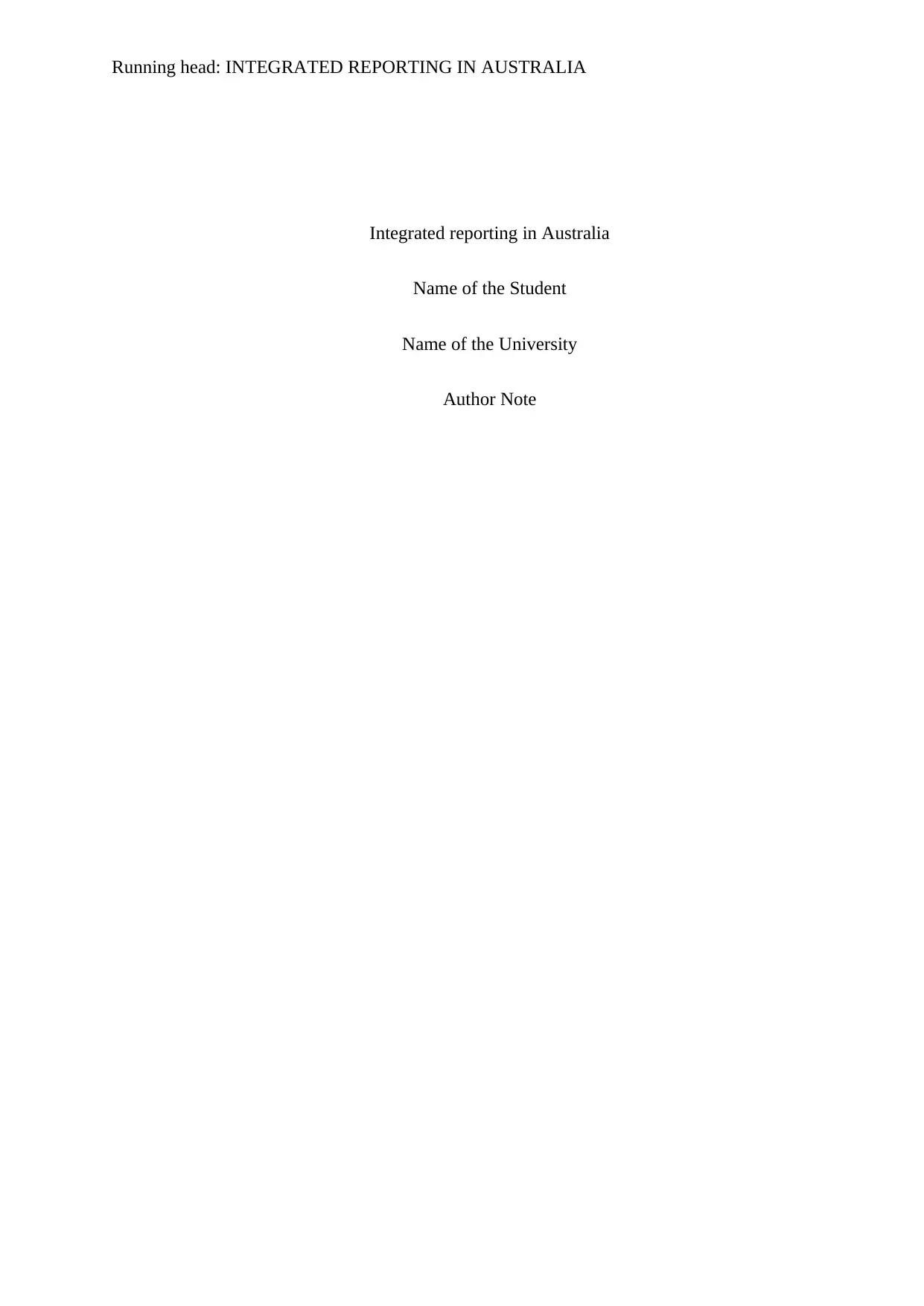
Running head: INTEGRATED REPORTING IN AUSTRALIA
Integrated reporting in Australia
Name of the Student
Name of the University
Author Note
Integrated reporting in Australia
Name of the Student
Name of the University
Author Note
Paraphrase This Document
Need a fresh take? Get an instant paraphrase of this document with our AI Paraphraser
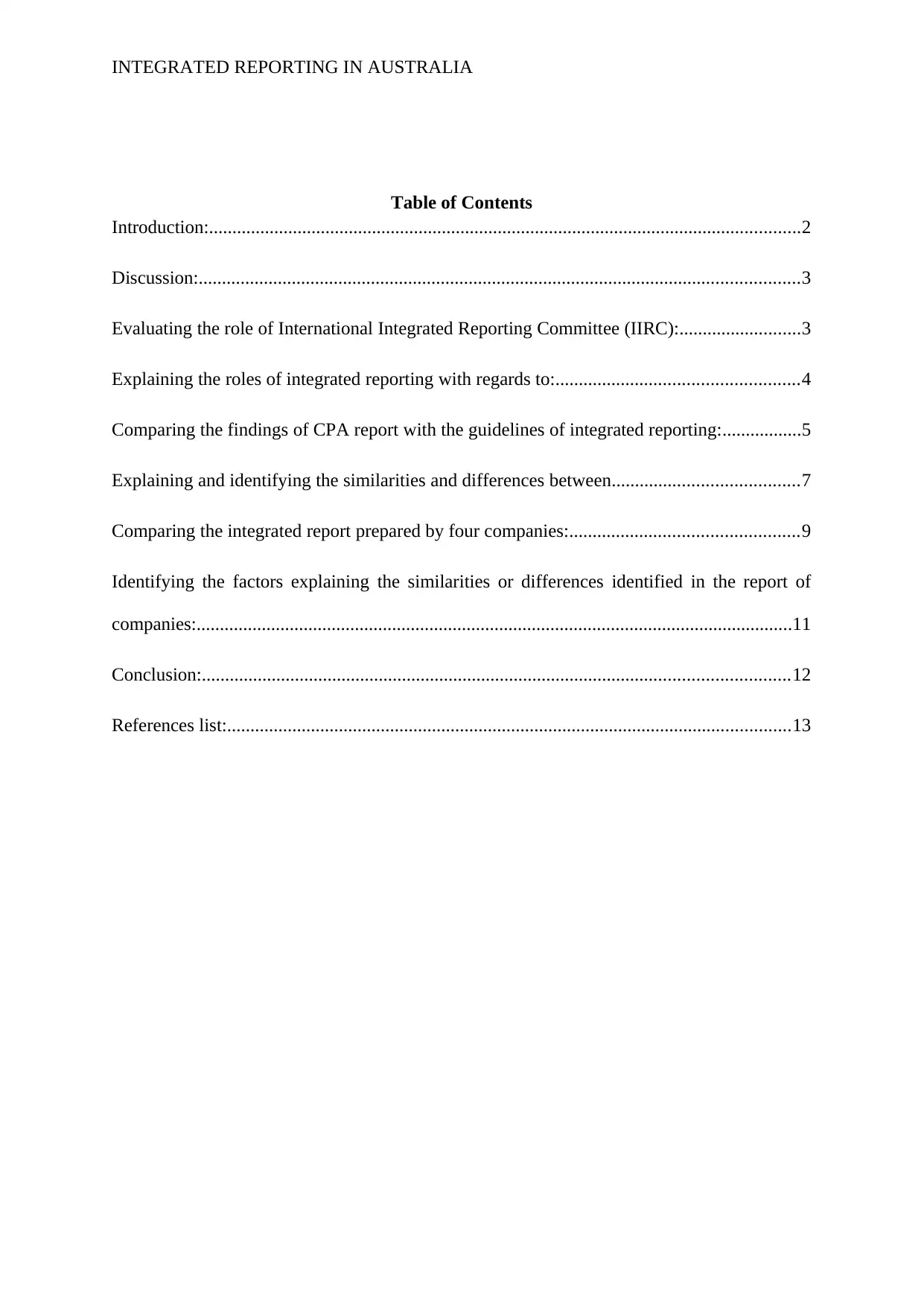
INTEGRATED REPORTING IN AUSTRALIA
Table of Contents
Introduction:...............................................................................................................................2
Discussion:.................................................................................................................................3
Evaluating the role of International Integrated Reporting Committee (IIRC):..........................3
Explaining the roles of integrated reporting with regards to:....................................................4
Comparing the findings of CPA report with the guidelines of integrated reporting:.................5
Explaining and identifying the similarities and differences between........................................7
Comparing the integrated report prepared by four companies:.................................................9
Identifying the factors explaining the similarities or differences identified in the report of
companies:................................................................................................................................11
Conclusion:..............................................................................................................................12
References list:.........................................................................................................................13
Table of Contents
Introduction:...............................................................................................................................2
Discussion:.................................................................................................................................3
Evaluating the role of International Integrated Reporting Committee (IIRC):..........................3
Explaining the roles of integrated reporting with regards to:....................................................4
Comparing the findings of CPA report with the guidelines of integrated reporting:.................5
Explaining and identifying the similarities and differences between........................................7
Comparing the integrated report prepared by four companies:.................................................9
Identifying the factors explaining the similarities or differences identified in the report of
companies:................................................................................................................................11
Conclusion:..............................................................................................................................12
References list:.........................................................................................................................13
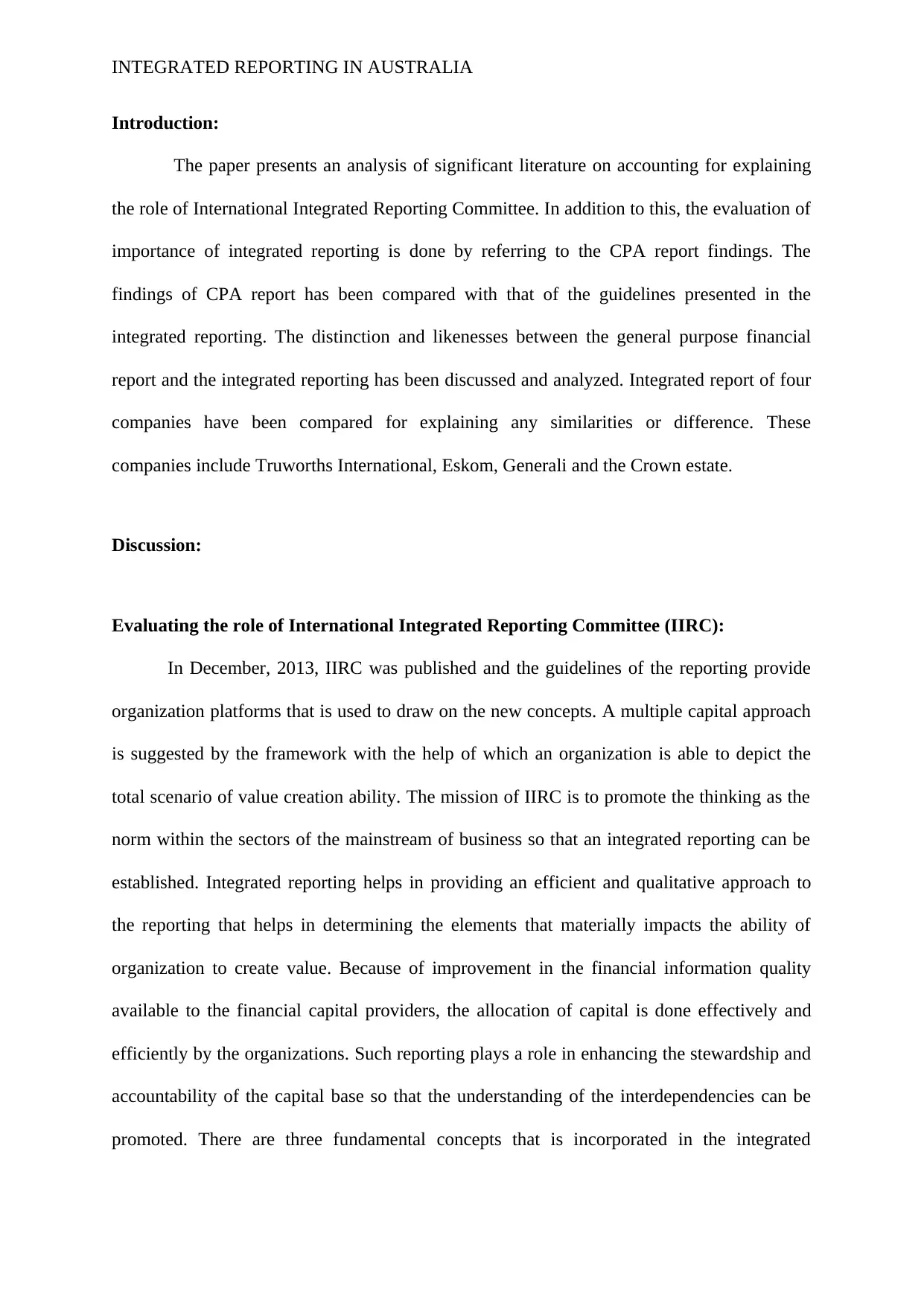
INTEGRATED REPORTING IN AUSTRALIA
Introduction:
The paper presents an analysis of significant literature on accounting for explaining
the role of International Integrated Reporting Committee. In addition to this, the evaluation of
importance of integrated reporting is done by referring to the CPA report findings. The
findings of CPA report has been compared with that of the guidelines presented in the
integrated reporting. The distinction and likenesses between the general purpose financial
report and the integrated reporting has been discussed and analyzed. Integrated report of four
companies have been compared for explaining any similarities or difference. These
companies include Truworths International, Eskom, Generali and the Crown estate.
Discussion:
Evaluating the role of International Integrated Reporting Committee (IIRC):
In December, 2013, IIRC was published and the guidelines of the reporting provide
organization platforms that is used to draw on the new concepts. A multiple capital approach
is suggested by the framework with the help of which an organization is able to depict the
total scenario of value creation ability. The mission of IIRC is to promote the thinking as the
norm within the sectors of the mainstream of business so that an integrated reporting can be
established. Integrated reporting helps in providing an efficient and qualitative approach to
the reporting that helps in determining the elements that materially impacts the ability of
organization to create value. Because of improvement in the financial information quality
available to the financial capital providers, the allocation of capital is done effectively and
efficiently by the organizations. Such reporting plays a role in enhancing the stewardship and
accountability of the capital base so that the understanding of the interdependencies can be
promoted. There are three fundamental concepts that is incorporated in the integrated
Introduction:
The paper presents an analysis of significant literature on accounting for explaining
the role of International Integrated Reporting Committee. In addition to this, the evaluation of
importance of integrated reporting is done by referring to the CPA report findings. The
findings of CPA report has been compared with that of the guidelines presented in the
integrated reporting. The distinction and likenesses between the general purpose financial
report and the integrated reporting has been discussed and analyzed. Integrated report of four
companies have been compared for explaining any similarities or difference. These
companies include Truworths International, Eskom, Generali and the Crown estate.
Discussion:
Evaluating the role of International Integrated Reporting Committee (IIRC):
In December, 2013, IIRC was published and the guidelines of the reporting provide
organization platforms that is used to draw on the new concepts. A multiple capital approach
is suggested by the framework with the help of which an organization is able to depict the
total scenario of value creation ability. The mission of IIRC is to promote the thinking as the
norm within the sectors of the mainstream of business so that an integrated reporting can be
established. Integrated reporting helps in providing an efficient and qualitative approach to
the reporting that helps in determining the elements that materially impacts the ability of
organization to create value. Because of improvement in the financial information quality
available to the financial capital providers, the allocation of capital is done effectively and
efficiently by the organizations. Such reporting plays a role in enhancing the stewardship and
accountability of the capital base so that the understanding of the interdependencies can be
promoted. There are three fundamental concepts that is incorporated in the integrated
⊘ This is a preview!⊘
Do you want full access?
Subscribe today to unlock all pages.

Trusted by 1+ million students worldwide
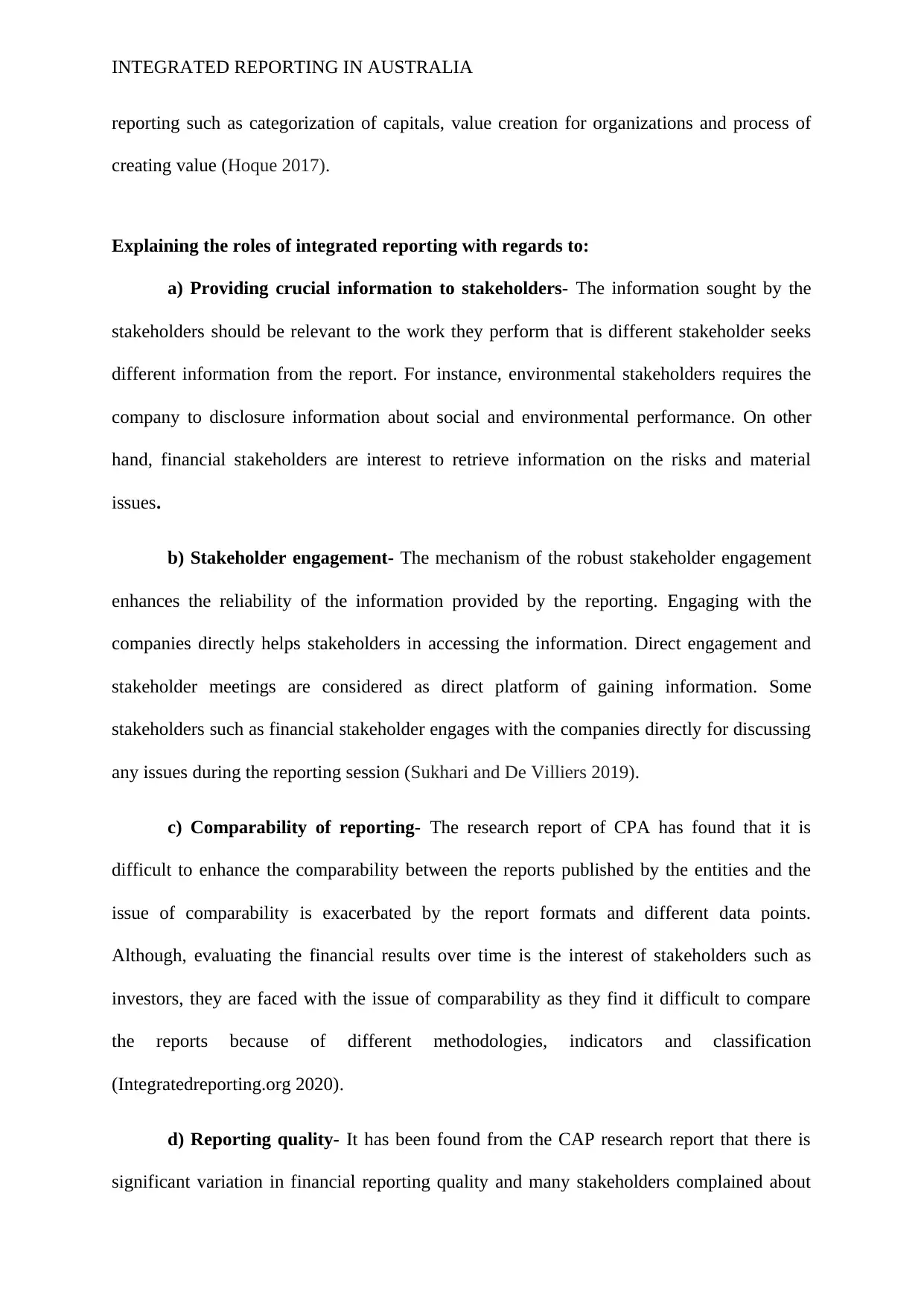
INTEGRATED REPORTING IN AUSTRALIA
reporting such as categorization of capitals, value creation for organizations and process of
creating value (Hoque 2017).
Explaining the roles of integrated reporting with regards to:
a) Providing crucial information to stakeholders- The information sought by the
stakeholders should be relevant to the work they perform that is different stakeholder seeks
different information from the report. For instance, environmental stakeholders requires the
company to disclosure information about social and environmental performance. On other
hand, financial stakeholders are interest to retrieve information on the risks and material
issues.
b) Stakeholder engagement- The mechanism of the robust stakeholder engagement
enhances the reliability of the information provided by the reporting. Engaging with the
companies directly helps stakeholders in accessing the information. Direct engagement and
stakeholder meetings are considered as direct platform of gaining information. Some
stakeholders such as financial stakeholder engages with the companies directly for discussing
any issues during the reporting session (Sukhari and De Villiers 2019).
c) Comparability of reporting- The research report of CPA has found that it is
difficult to enhance the comparability between the reports published by the entities and the
issue of comparability is exacerbated by the report formats and different data points.
Although, evaluating the financial results over time is the interest of stakeholders such as
investors, they are faced with the issue of comparability as they find it difficult to compare
the reports because of different methodologies, indicators and classification
(Integratedreporting.org 2020).
d) Reporting quality- It has been found from the CAP research report that there is
significant variation in financial reporting quality and many stakeholders complained about
reporting such as categorization of capitals, value creation for organizations and process of
creating value (Hoque 2017).
Explaining the roles of integrated reporting with regards to:
a) Providing crucial information to stakeholders- The information sought by the
stakeholders should be relevant to the work they perform that is different stakeholder seeks
different information from the report. For instance, environmental stakeholders requires the
company to disclosure information about social and environmental performance. On other
hand, financial stakeholders are interest to retrieve information on the risks and material
issues.
b) Stakeholder engagement- The mechanism of the robust stakeholder engagement
enhances the reliability of the information provided by the reporting. Engaging with the
companies directly helps stakeholders in accessing the information. Direct engagement and
stakeholder meetings are considered as direct platform of gaining information. Some
stakeholders such as financial stakeholder engages with the companies directly for discussing
any issues during the reporting session (Sukhari and De Villiers 2019).
c) Comparability of reporting- The research report of CPA has found that it is
difficult to enhance the comparability between the reports published by the entities and the
issue of comparability is exacerbated by the report formats and different data points.
Although, evaluating the financial results over time is the interest of stakeholders such as
investors, they are faced with the issue of comparability as they find it difficult to compare
the reports because of different methodologies, indicators and classification
(Integratedreporting.org 2020).
d) Reporting quality- It has been found from the CAP research report that there is
significant variation in financial reporting quality and many stakeholders complained about
Paraphrase This Document
Need a fresh take? Get an instant paraphrase of this document with our AI Paraphraser
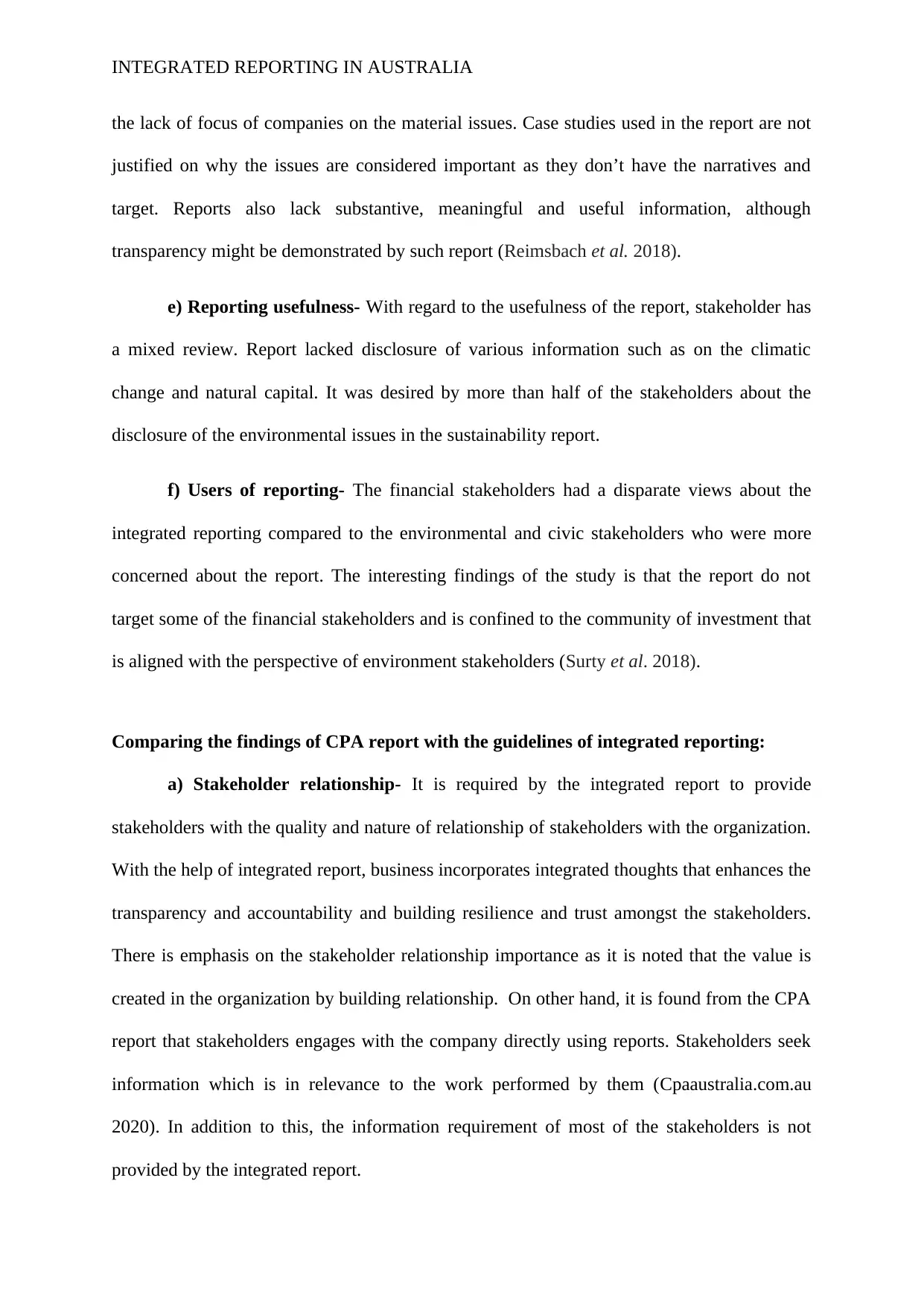
INTEGRATED REPORTING IN AUSTRALIA
the lack of focus of companies on the material issues. Case studies used in the report are not
justified on why the issues are considered important as they don’t have the narratives and
target. Reports also lack substantive, meaningful and useful information, although
transparency might be demonstrated by such report (Reimsbach et al. 2018).
e) Reporting usefulness- With regard to the usefulness of the report, stakeholder has
a mixed review. Report lacked disclosure of various information such as on the climatic
change and natural capital. It was desired by more than half of the stakeholders about the
disclosure of the environmental issues in the sustainability report.
f) Users of reporting- The financial stakeholders had a disparate views about the
integrated reporting compared to the environmental and civic stakeholders who were more
concerned about the report. The interesting findings of the study is that the report do not
target some of the financial stakeholders and is confined to the community of investment that
is aligned with the perspective of environment stakeholders (Surty et al. 2018).
Comparing the findings of CPA report with the guidelines of integrated reporting:
a) Stakeholder relationship- It is required by the integrated report to provide
stakeholders with the quality and nature of relationship of stakeholders with the organization.
With the help of integrated report, business incorporates integrated thoughts that enhances the
transparency and accountability and building resilience and trust amongst the stakeholders.
There is emphasis on the stakeholder relationship importance as it is noted that the value is
created in the organization by building relationship. On other hand, it is found from the CPA
report that stakeholders engages with the company directly using reports. Stakeholders seek
information which is in relevance to the work performed by them (Cpaaustralia.com.au
2020). In addition to this, the information requirement of most of the stakeholders is not
provided by the integrated report.
the lack of focus of companies on the material issues. Case studies used in the report are not
justified on why the issues are considered important as they don’t have the narratives and
target. Reports also lack substantive, meaningful and useful information, although
transparency might be demonstrated by such report (Reimsbach et al. 2018).
e) Reporting usefulness- With regard to the usefulness of the report, stakeholder has
a mixed review. Report lacked disclosure of various information such as on the climatic
change and natural capital. It was desired by more than half of the stakeholders about the
disclosure of the environmental issues in the sustainability report.
f) Users of reporting- The financial stakeholders had a disparate views about the
integrated reporting compared to the environmental and civic stakeholders who were more
concerned about the report. The interesting findings of the study is that the report do not
target some of the financial stakeholders and is confined to the community of investment that
is aligned with the perspective of environment stakeholders (Surty et al. 2018).
Comparing the findings of CPA report with the guidelines of integrated reporting:
a) Stakeholder relationship- It is required by the integrated report to provide
stakeholders with the quality and nature of relationship of stakeholders with the organization.
With the help of integrated report, business incorporates integrated thoughts that enhances the
transparency and accountability and building resilience and trust amongst the stakeholders.
There is emphasis on the stakeholder relationship importance as it is noted that the value is
created in the organization by building relationship. On other hand, it is found from the CPA
report that stakeholders engages with the company directly using reports. Stakeholders seek
information which is in relevance to the work performed by them (Cpaaustralia.com.au
2020). In addition to this, the information requirement of most of the stakeholders is not
provided by the integrated report.
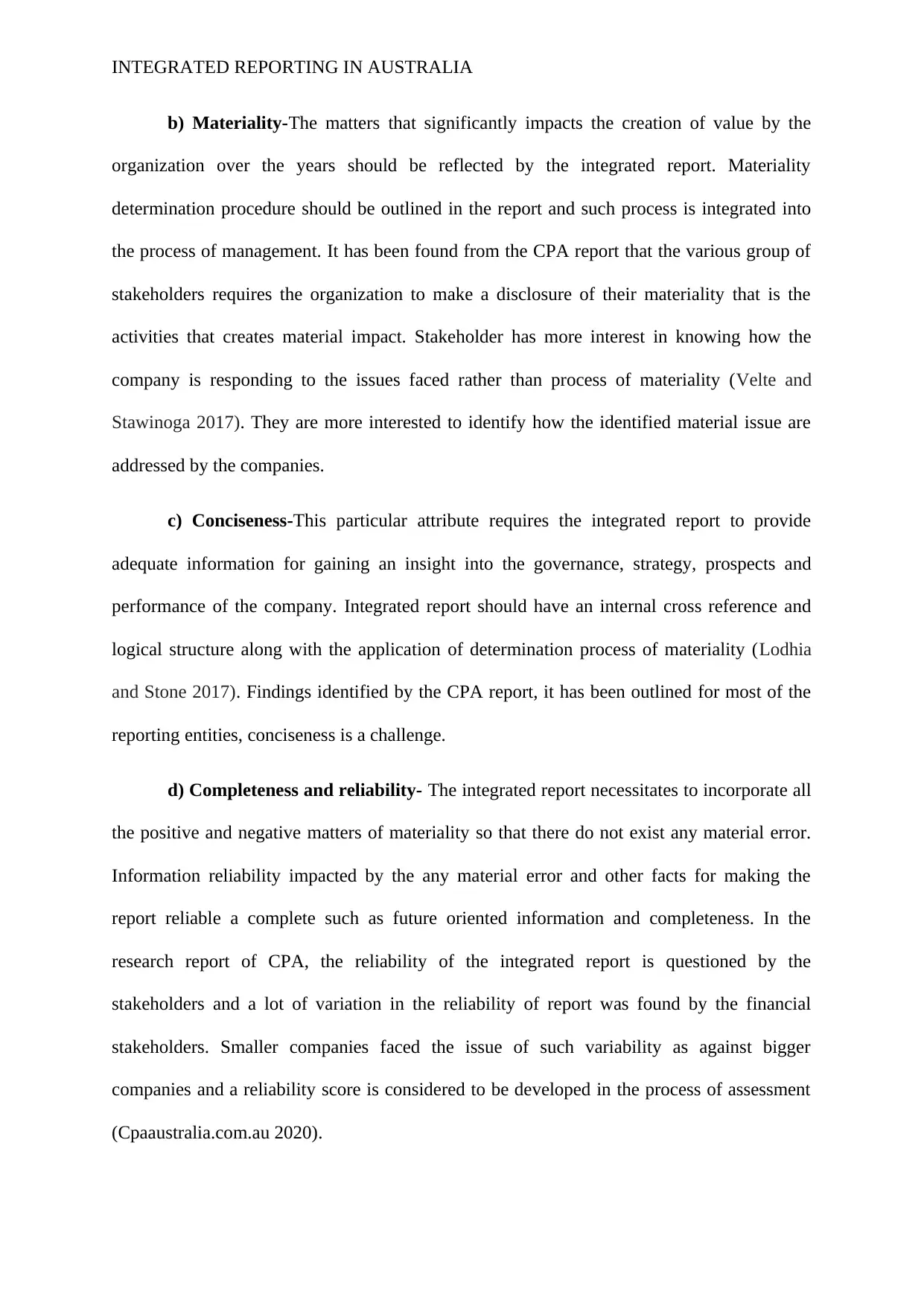
INTEGRATED REPORTING IN AUSTRALIA
b) Materiality-The matters that significantly impacts the creation of value by the
organization over the years should be reflected by the integrated report. Materiality
determination procedure should be outlined in the report and such process is integrated into
the process of management. It has been found from the CPA report that the various group of
stakeholders requires the organization to make a disclosure of their materiality that is the
activities that creates material impact. Stakeholder has more interest in knowing how the
company is responding to the issues faced rather than process of materiality (Velte and
Stawinoga 2017). They are more interested to identify how the identified material issue are
addressed by the companies.
c) Conciseness-This particular attribute requires the integrated report to provide
adequate information for gaining an insight into the governance, strategy, prospects and
performance of the company. Integrated report should have an internal cross reference and
logical structure along with the application of determination process of materiality (Lodhia
and Stone 2017). Findings identified by the CPA report, it has been outlined for most of the
reporting entities, conciseness is a challenge.
d) Completeness and reliability- The integrated report necessitates to incorporate all
the positive and negative matters of materiality so that there do not exist any material error.
Information reliability impacted by the any material error and other facts for making the
report reliable a complete such as future oriented information and completeness. In the
research report of CPA, the reliability of the integrated report is questioned by the
stakeholders and a lot of variation in the reliability of report was found by the financial
stakeholders. Smaller companies faced the issue of such variability as against bigger
companies and a reliability score is considered to be developed in the process of assessment
(Cpaaustralia.com.au 2020).
b) Materiality-The matters that significantly impacts the creation of value by the
organization over the years should be reflected by the integrated report. Materiality
determination procedure should be outlined in the report and such process is integrated into
the process of management. It has been found from the CPA report that the various group of
stakeholders requires the organization to make a disclosure of their materiality that is the
activities that creates material impact. Stakeholder has more interest in knowing how the
company is responding to the issues faced rather than process of materiality (Velte and
Stawinoga 2017). They are more interested to identify how the identified material issue are
addressed by the companies.
c) Conciseness-This particular attribute requires the integrated report to provide
adequate information for gaining an insight into the governance, strategy, prospects and
performance of the company. Integrated report should have an internal cross reference and
logical structure along with the application of determination process of materiality (Lodhia
and Stone 2017). Findings identified by the CPA report, it has been outlined for most of the
reporting entities, conciseness is a challenge.
d) Completeness and reliability- The integrated report necessitates to incorporate all
the positive and negative matters of materiality so that there do not exist any material error.
Information reliability impacted by the any material error and other facts for making the
report reliable a complete such as future oriented information and completeness. In the
research report of CPA, the reliability of the integrated report is questioned by the
stakeholders and a lot of variation in the reliability of report was found by the financial
stakeholders. Smaller companies faced the issue of such variability as against bigger
companies and a reliability score is considered to be developed in the process of assessment
(Cpaaustralia.com.au 2020).
⊘ This is a preview!⊘
Do you want full access?
Subscribe today to unlock all pages.

Trusted by 1+ million students worldwide
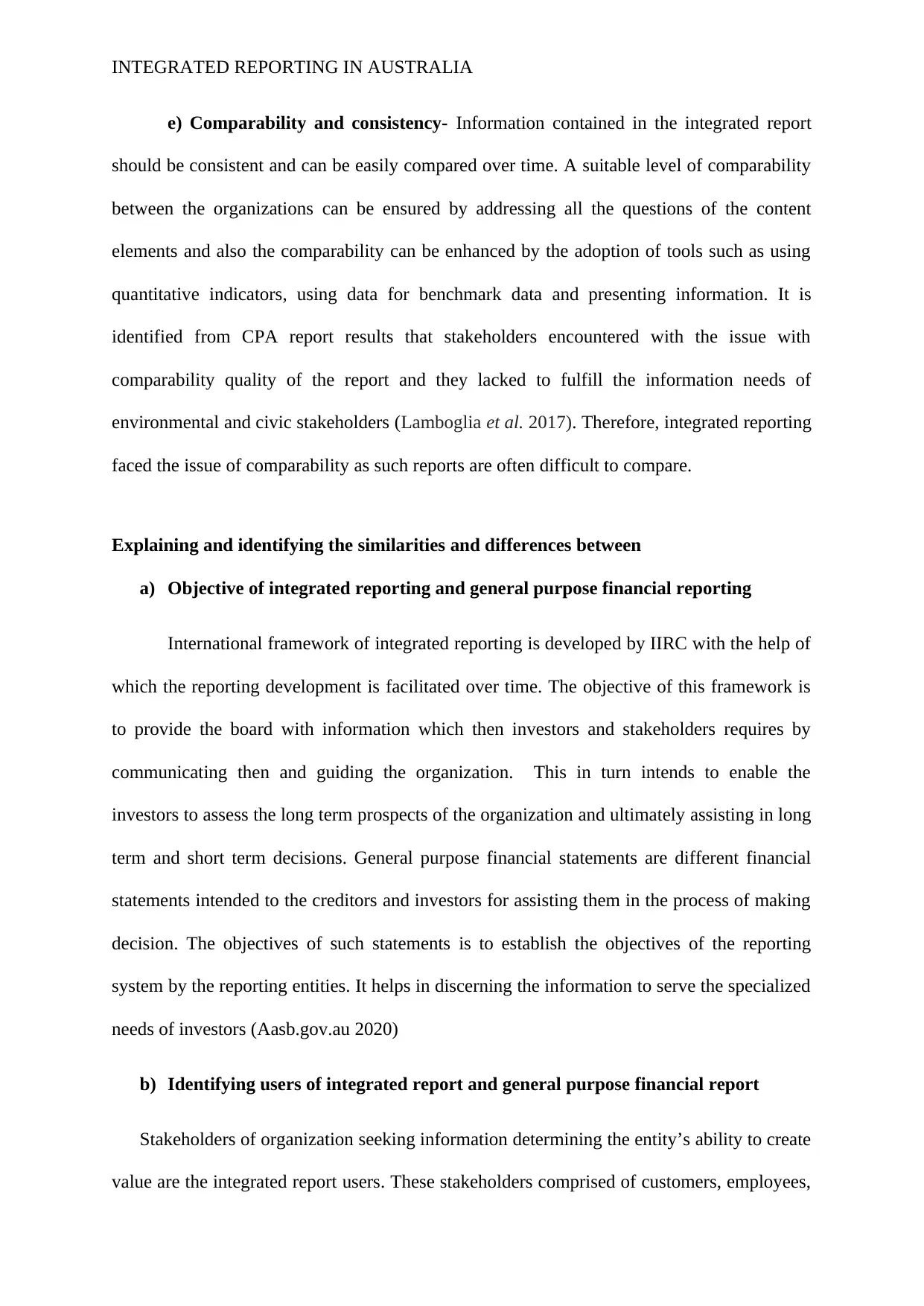
INTEGRATED REPORTING IN AUSTRALIA
e) Comparability and consistency- Information contained in the integrated report
should be consistent and can be easily compared over time. A suitable level of comparability
between the organizations can be ensured by addressing all the questions of the content
elements and also the comparability can be enhanced by the adoption of tools such as using
quantitative indicators, using data for benchmark data and presenting information. It is
identified from CPA report results that stakeholders encountered with the issue with
comparability quality of the report and they lacked to fulfill the information needs of
environmental and civic stakeholders (Lamboglia et al. 2017). Therefore, integrated reporting
faced the issue of comparability as such reports are often difficult to compare.
Explaining and identifying the similarities and differences between
a) Objective of integrated reporting and general purpose financial reporting
International framework of integrated reporting is developed by IIRC with the help of
which the reporting development is facilitated over time. The objective of this framework is
to provide the board with information which then investors and stakeholders requires by
communicating then and guiding the organization. This in turn intends to enable the
investors to assess the long term prospects of the organization and ultimately assisting in long
term and short term decisions. General purpose financial statements are different financial
statements intended to the creditors and investors for assisting them in the process of making
decision. The objectives of such statements is to establish the objectives of the reporting
system by the reporting entities. It helps in discerning the information to serve the specialized
needs of investors (Aasb.gov.au 2020)
b) Identifying users of integrated report and general purpose financial report
Stakeholders of organization seeking information determining the entity’s ability to create
value are the integrated report users. These stakeholders comprised of customers, employees,
e) Comparability and consistency- Information contained in the integrated report
should be consistent and can be easily compared over time. A suitable level of comparability
between the organizations can be ensured by addressing all the questions of the content
elements and also the comparability can be enhanced by the adoption of tools such as using
quantitative indicators, using data for benchmark data and presenting information. It is
identified from CPA report results that stakeholders encountered with the issue with
comparability quality of the report and they lacked to fulfill the information needs of
environmental and civic stakeholders (Lamboglia et al. 2017). Therefore, integrated reporting
faced the issue of comparability as such reports are often difficult to compare.
Explaining and identifying the similarities and differences between
a) Objective of integrated reporting and general purpose financial reporting
International framework of integrated reporting is developed by IIRC with the help of
which the reporting development is facilitated over time. The objective of this framework is
to provide the board with information which then investors and stakeholders requires by
communicating then and guiding the organization. This in turn intends to enable the
investors to assess the long term prospects of the organization and ultimately assisting in long
term and short term decisions. General purpose financial statements are different financial
statements intended to the creditors and investors for assisting them in the process of making
decision. The objectives of such statements is to establish the objectives of the reporting
system by the reporting entities. It helps in discerning the information to serve the specialized
needs of investors (Aasb.gov.au 2020)
b) Identifying users of integrated report and general purpose financial report
Stakeholders of organization seeking information determining the entity’s ability to create
value are the integrated report users. These stakeholders comprised of customers, employees,
Paraphrase This Document
Need a fresh take? Get an instant paraphrase of this document with our AI Paraphraser
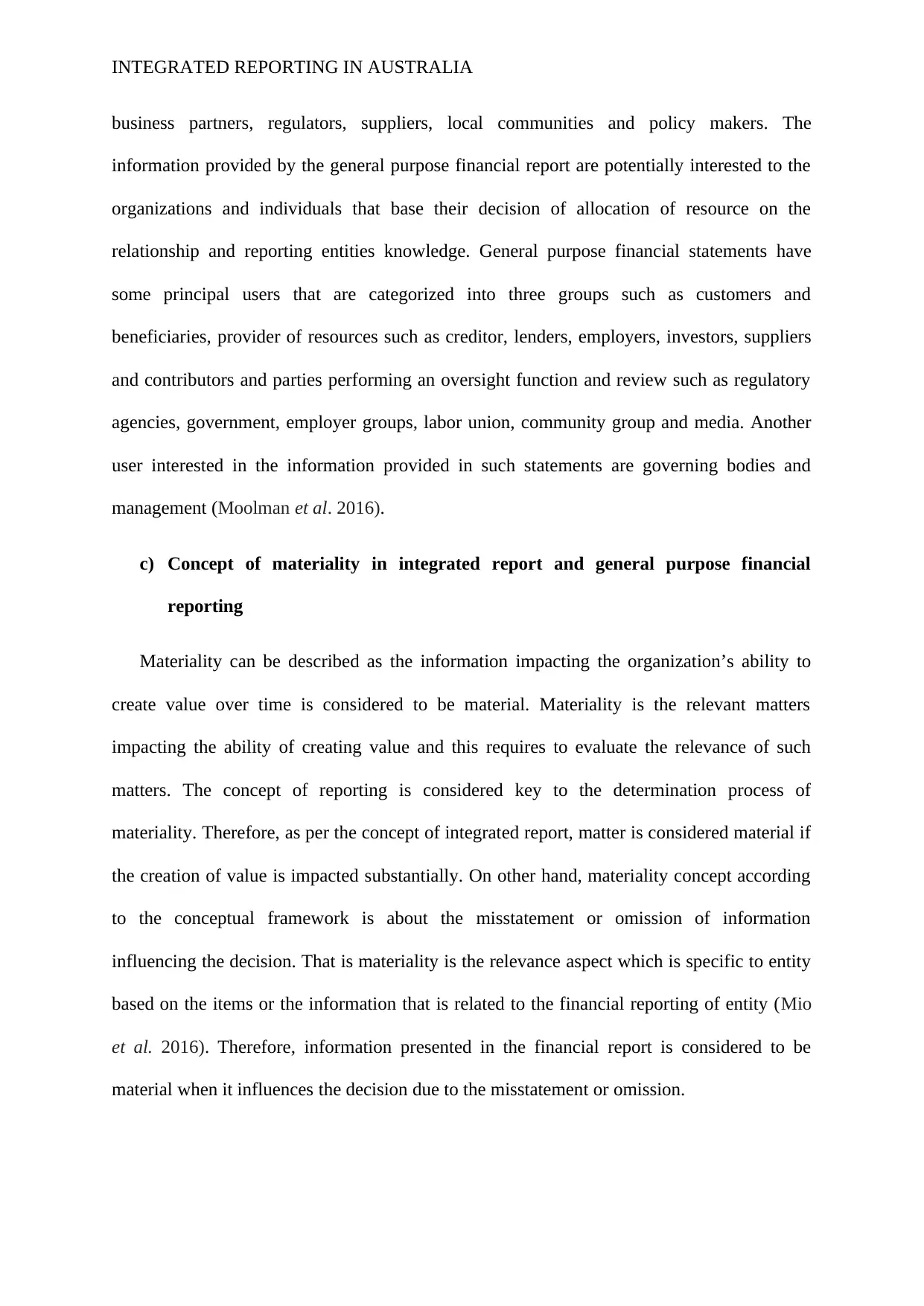
INTEGRATED REPORTING IN AUSTRALIA
business partners, regulators, suppliers, local communities and policy makers. The
information provided by the general purpose financial report are potentially interested to the
organizations and individuals that base their decision of allocation of resource on the
relationship and reporting entities knowledge. General purpose financial statements have
some principal users that are categorized into three groups such as customers and
beneficiaries, provider of resources such as creditor, lenders, employers, investors, suppliers
and contributors and parties performing an oversight function and review such as regulatory
agencies, government, employer groups, labor union, community group and media. Another
user interested in the information provided in such statements are governing bodies and
management (Moolman et al. 2016).
c) Concept of materiality in integrated report and general purpose financial
reporting
Materiality can be described as the information impacting the organization’s ability to
create value over time is considered to be material. Materiality is the relevant matters
impacting the ability of creating value and this requires to evaluate the relevance of such
matters. The concept of reporting is considered key to the determination process of
materiality. Therefore, as per the concept of integrated report, matter is considered material if
the creation of value is impacted substantially. On other hand, materiality concept according
to the conceptual framework is about the misstatement or omission of information
influencing the decision. That is materiality is the relevance aspect which is specific to entity
based on the items or the information that is related to the financial reporting of entity (Mio
et al. 2016). Therefore, information presented in the financial report is considered to be
material when it influences the decision due to the misstatement or omission.
business partners, regulators, suppliers, local communities and policy makers. The
information provided by the general purpose financial report are potentially interested to the
organizations and individuals that base their decision of allocation of resource on the
relationship and reporting entities knowledge. General purpose financial statements have
some principal users that are categorized into three groups such as customers and
beneficiaries, provider of resources such as creditor, lenders, employers, investors, suppliers
and contributors and parties performing an oversight function and review such as regulatory
agencies, government, employer groups, labor union, community group and media. Another
user interested in the information provided in such statements are governing bodies and
management (Moolman et al. 2016).
c) Concept of materiality in integrated report and general purpose financial
reporting
Materiality can be described as the information impacting the organization’s ability to
create value over time is considered to be material. Materiality is the relevant matters
impacting the ability of creating value and this requires to evaluate the relevance of such
matters. The concept of reporting is considered key to the determination process of
materiality. Therefore, as per the concept of integrated report, matter is considered material if
the creation of value is impacted substantially. On other hand, materiality concept according
to the conceptual framework is about the misstatement or omission of information
influencing the decision. That is materiality is the relevance aspect which is specific to entity
based on the items or the information that is related to the financial reporting of entity (Mio
et al. 2016). Therefore, information presented in the financial report is considered to be
material when it influences the decision due to the misstatement or omission.
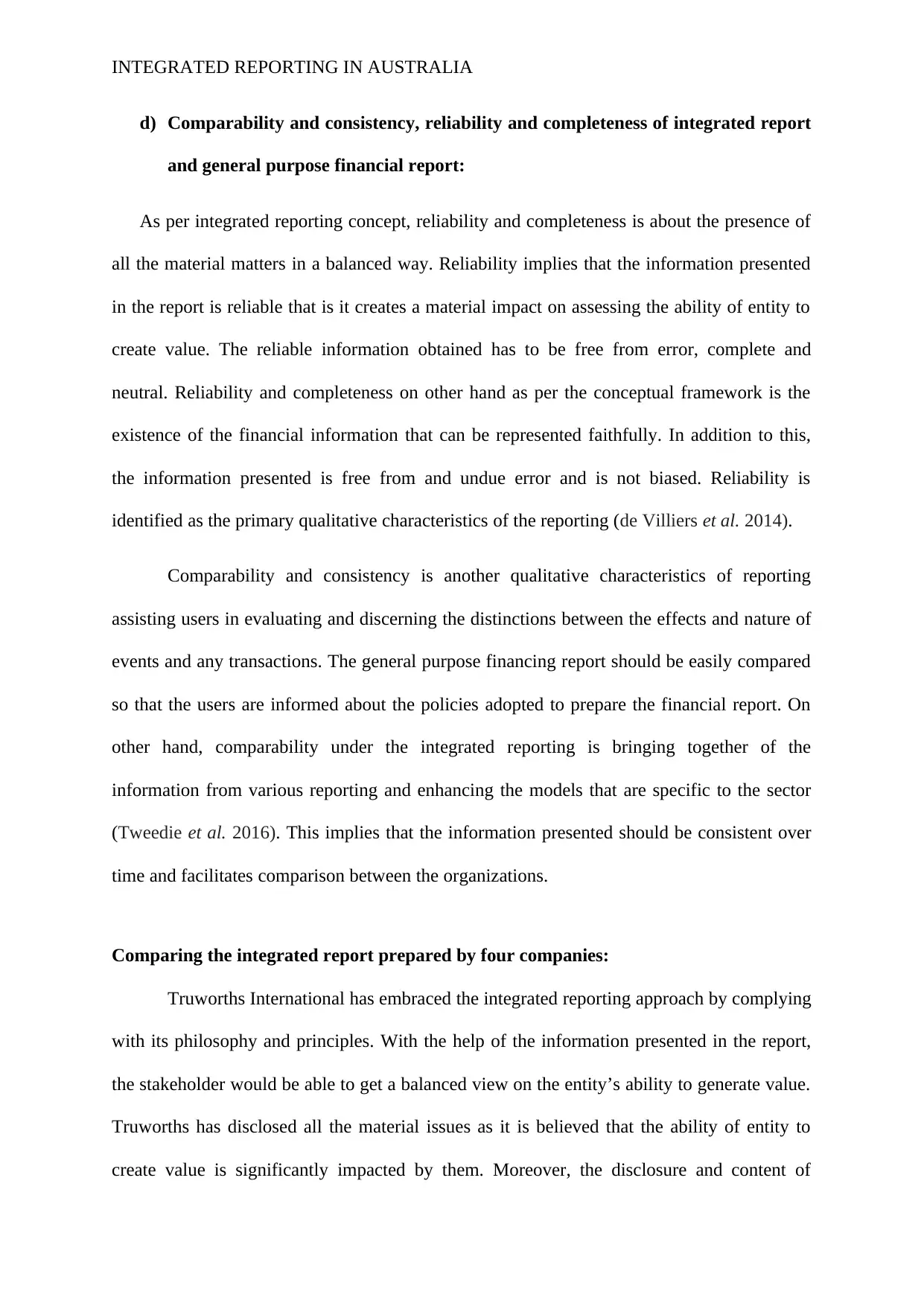
INTEGRATED REPORTING IN AUSTRALIA
d) Comparability and consistency, reliability and completeness of integrated report
and general purpose financial report:
As per integrated reporting concept, reliability and completeness is about the presence of
all the material matters in a balanced way. Reliability implies that the information presented
in the report is reliable that is it creates a material impact on assessing the ability of entity to
create value. The reliable information obtained has to be free from error, complete and
neutral. Reliability and completeness on other hand as per the conceptual framework is the
existence of the financial information that can be represented faithfully. In addition to this,
the information presented is free from and undue error and is not biased. Reliability is
identified as the primary qualitative characteristics of the reporting (de Villiers et al. 2014).
Comparability and consistency is another qualitative characteristics of reporting
assisting users in evaluating and discerning the distinctions between the effects and nature of
events and any transactions. The general purpose financing report should be easily compared
so that the users are informed about the policies adopted to prepare the financial report. On
other hand, comparability under the integrated reporting is bringing together of the
information from various reporting and enhancing the models that are specific to the sector
(Tweedie et al. 2016). This implies that the information presented should be consistent over
time and facilitates comparison between the organizations.
Comparing the integrated report prepared by four companies:
Truworths International has embraced the integrated reporting approach by complying
with its philosophy and principles. With the help of the information presented in the report,
the stakeholder would be able to get a balanced view on the entity’s ability to generate value.
Truworths has disclosed all the material issues as it is believed that the ability of entity to
create value is significantly impacted by them. Moreover, the disclosure and content of
d) Comparability and consistency, reliability and completeness of integrated report
and general purpose financial report:
As per integrated reporting concept, reliability and completeness is about the presence of
all the material matters in a balanced way. Reliability implies that the information presented
in the report is reliable that is it creates a material impact on assessing the ability of entity to
create value. The reliable information obtained has to be free from error, complete and
neutral. Reliability and completeness on other hand as per the conceptual framework is the
existence of the financial information that can be represented faithfully. In addition to this,
the information presented is free from and undue error and is not biased. Reliability is
identified as the primary qualitative characteristics of the reporting (de Villiers et al. 2014).
Comparability and consistency is another qualitative characteristics of reporting
assisting users in evaluating and discerning the distinctions between the effects and nature of
events and any transactions. The general purpose financing report should be easily compared
so that the users are informed about the policies adopted to prepare the financial report. On
other hand, comparability under the integrated reporting is bringing together of the
information from various reporting and enhancing the models that are specific to the sector
(Tweedie et al. 2016). This implies that the information presented should be consistent over
time and facilitates comparison between the organizations.
Comparing the integrated report prepared by four companies:
Truworths International has embraced the integrated reporting approach by complying
with its philosophy and principles. With the help of the information presented in the report,
the stakeholder would be able to get a balanced view on the entity’s ability to generate value.
Truworths has disclosed all the material issues as it is believed that the ability of entity to
create value is significantly impacted by them. Moreover, the disclosure and content of
⊘ This is a preview!⊘
Do you want full access?
Subscribe today to unlock all pages.

Trusted by 1+ million students worldwide
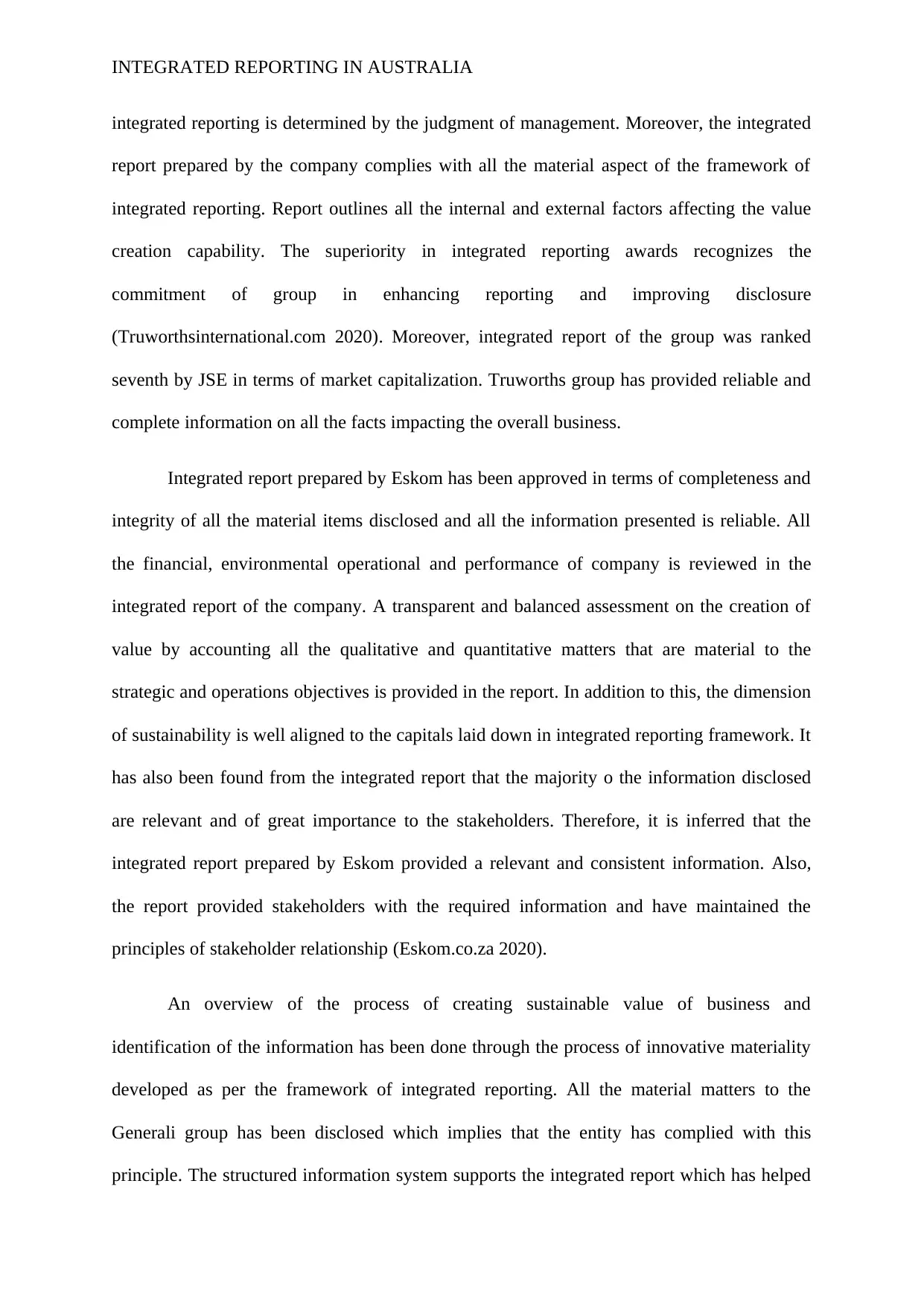
INTEGRATED REPORTING IN AUSTRALIA
integrated reporting is determined by the judgment of management. Moreover, the integrated
report prepared by the company complies with all the material aspect of the framework of
integrated reporting. Report outlines all the internal and external factors affecting the value
creation capability. The superiority in integrated reporting awards recognizes the
commitment of group in enhancing reporting and improving disclosure
(Truworthsinternational.com 2020). Moreover, integrated report of the group was ranked
seventh by JSE in terms of market capitalization. Truworths group has provided reliable and
complete information on all the facts impacting the overall business.
Integrated report prepared by Eskom has been approved in terms of completeness and
integrity of all the material items disclosed and all the information presented is reliable. All
the financial, environmental operational and performance of company is reviewed in the
integrated report of the company. A transparent and balanced assessment on the creation of
value by accounting all the qualitative and quantitative matters that are material to the
strategic and operations objectives is provided in the report. In addition to this, the dimension
of sustainability is well aligned to the capitals laid down in integrated reporting framework. It
has also been found from the integrated report that the majority o the information disclosed
are relevant and of great importance to the stakeholders. Therefore, it is inferred that the
integrated report prepared by Eskom provided a relevant and consistent information. Also,
the report provided stakeholders with the required information and have maintained the
principles of stakeholder relationship (Eskom.co.za 2020).
An overview of the process of creating sustainable value of business and
identification of the information has been done through the process of innovative materiality
developed as per the framework of integrated reporting. All the material matters to the
Generali group has been disclosed which implies that the entity has complied with this
principle. The structured information system supports the integrated report which has helped
integrated reporting is determined by the judgment of management. Moreover, the integrated
report prepared by the company complies with all the material aspect of the framework of
integrated reporting. Report outlines all the internal and external factors affecting the value
creation capability. The superiority in integrated reporting awards recognizes the
commitment of group in enhancing reporting and improving disclosure
(Truworthsinternational.com 2020). Moreover, integrated report of the group was ranked
seventh by JSE in terms of market capitalization. Truworths group has provided reliable and
complete information on all the facts impacting the overall business.
Integrated report prepared by Eskom has been approved in terms of completeness and
integrity of all the material items disclosed and all the information presented is reliable. All
the financial, environmental operational and performance of company is reviewed in the
integrated report of the company. A transparent and balanced assessment on the creation of
value by accounting all the qualitative and quantitative matters that are material to the
strategic and operations objectives is provided in the report. In addition to this, the dimension
of sustainability is well aligned to the capitals laid down in integrated reporting framework. It
has also been found from the integrated report that the majority o the information disclosed
are relevant and of great importance to the stakeholders. Therefore, it is inferred that the
integrated report prepared by Eskom provided a relevant and consistent information. Also,
the report provided stakeholders with the required information and have maintained the
principles of stakeholder relationship (Eskom.co.za 2020).
An overview of the process of creating sustainable value of business and
identification of the information has been done through the process of innovative materiality
developed as per the framework of integrated reporting. All the material matters to the
Generali group has been disclosed which implies that the entity has complied with this
principle. The structured information system supports the integrated report which has helped
Paraphrase This Document
Need a fresh take? Get an instant paraphrase of this document with our AI Paraphraser
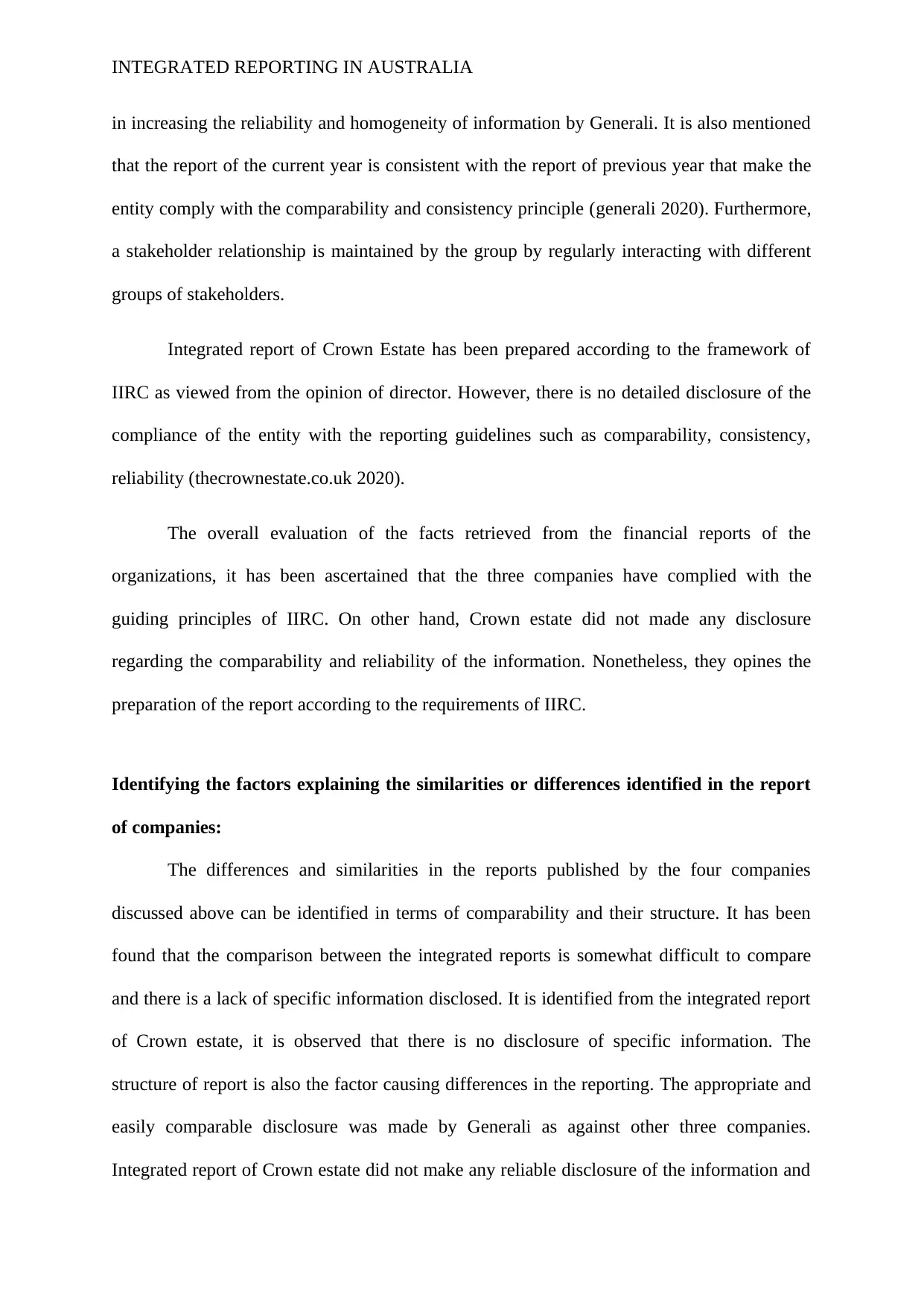
INTEGRATED REPORTING IN AUSTRALIA
in increasing the reliability and homogeneity of information by Generali. It is also mentioned
that the report of the current year is consistent with the report of previous year that make the
entity comply with the comparability and consistency principle (generali 2020). Furthermore,
a stakeholder relationship is maintained by the group by regularly interacting with different
groups of stakeholders.
Integrated report of Crown Estate has been prepared according to the framework of
IIRC as viewed from the opinion of director. However, there is no detailed disclosure of the
compliance of the entity with the reporting guidelines such as comparability, consistency,
reliability (thecrownestate.co.uk 2020).
The overall evaluation of the facts retrieved from the financial reports of the
organizations, it has been ascertained that the three companies have complied with the
guiding principles of IIRC. On other hand, Crown estate did not made any disclosure
regarding the comparability and reliability of the information. Nonetheless, they opines the
preparation of the report according to the requirements of IIRC.
Identifying the factors explaining the similarities or differences identified in the report
of companies:
The differences and similarities in the reports published by the four companies
discussed above can be identified in terms of comparability and their structure. It has been
found that the comparison between the integrated reports is somewhat difficult to compare
and there is a lack of specific information disclosed. It is identified from the integrated report
of Crown estate, it is observed that there is no disclosure of specific information. The
structure of report is also the factor causing differences in the reporting. The appropriate and
easily comparable disclosure was made by Generali as against other three companies.
Integrated report of Crown estate did not make any reliable disclosure of the information and
in increasing the reliability and homogeneity of information by Generali. It is also mentioned
that the report of the current year is consistent with the report of previous year that make the
entity comply with the comparability and consistency principle (generali 2020). Furthermore,
a stakeholder relationship is maintained by the group by regularly interacting with different
groups of stakeholders.
Integrated report of Crown Estate has been prepared according to the framework of
IIRC as viewed from the opinion of director. However, there is no detailed disclosure of the
compliance of the entity with the reporting guidelines such as comparability, consistency,
reliability (thecrownestate.co.uk 2020).
The overall evaluation of the facts retrieved from the financial reports of the
organizations, it has been ascertained that the three companies have complied with the
guiding principles of IIRC. On other hand, Crown estate did not made any disclosure
regarding the comparability and reliability of the information. Nonetheless, they opines the
preparation of the report according to the requirements of IIRC.
Identifying the factors explaining the similarities or differences identified in the report
of companies:
The differences and similarities in the reports published by the four companies
discussed above can be identified in terms of comparability and their structure. It has been
found that the comparison between the integrated reports is somewhat difficult to compare
and there is a lack of specific information disclosed. It is identified from the integrated report
of Crown estate, it is observed that there is no disclosure of specific information. The
structure of report is also the factor causing differences in the reporting. The appropriate and
easily comparable disclosure was made by Generali as against other three companies.
Integrated report of Crown estate did not make any reliable disclosure of the information and
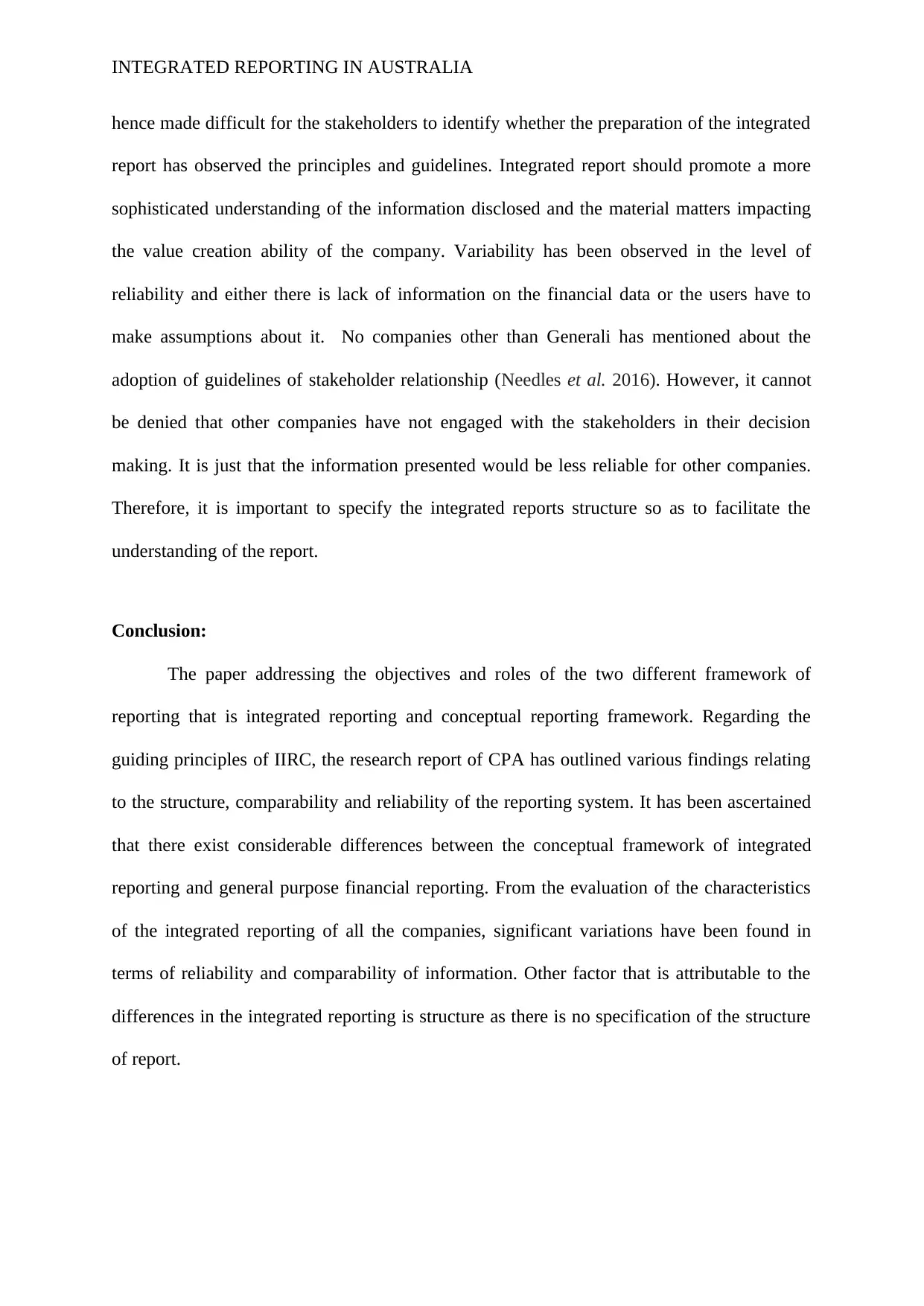
INTEGRATED REPORTING IN AUSTRALIA
hence made difficult for the stakeholders to identify whether the preparation of the integrated
report has observed the principles and guidelines. Integrated report should promote a more
sophisticated understanding of the information disclosed and the material matters impacting
the value creation ability of the company. Variability has been observed in the level of
reliability and either there is lack of information on the financial data or the users have to
make assumptions about it. No companies other than Generali has mentioned about the
adoption of guidelines of stakeholder relationship (Needles et al. 2016). However, it cannot
be denied that other companies have not engaged with the stakeholders in their decision
making. It is just that the information presented would be less reliable for other companies.
Therefore, it is important to specify the integrated reports structure so as to facilitate the
understanding of the report.
Conclusion:
The paper addressing the objectives and roles of the two different framework of
reporting that is integrated reporting and conceptual reporting framework. Regarding the
guiding principles of IIRC, the research report of CPA has outlined various findings relating
to the structure, comparability and reliability of the reporting system. It has been ascertained
that there exist considerable differences between the conceptual framework of integrated
reporting and general purpose financial reporting. From the evaluation of the characteristics
of the integrated reporting of all the companies, significant variations have been found in
terms of reliability and comparability of information. Other factor that is attributable to the
differences in the integrated reporting is structure as there is no specification of the structure
of report.
hence made difficult for the stakeholders to identify whether the preparation of the integrated
report has observed the principles and guidelines. Integrated report should promote a more
sophisticated understanding of the information disclosed and the material matters impacting
the value creation ability of the company. Variability has been observed in the level of
reliability and either there is lack of information on the financial data or the users have to
make assumptions about it. No companies other than Generali has mentioned about the
adoption of guidelines of stakeholder relationship (Needles et al. 2016). However, it cannot
be denied that other companies have not engaged with the stakeholders in their decision
making. It is just that the information presented would be less reliable for other companies.
Therefore, it is important to specify the integrated reports structure so as to facilitate the
understanding of the report.
Conclusion:
The paper addressing the objectives and roles of the two different framework of
reporting that is integrated reporting and conceptual reporting framework. Regarding the
guiding principles of IIRC, the research report of CPA has outlined various findings relating
to the structure, comparability and reliability of the reporting system. It has been ascertained
that there exist considerable differences between the conceptual framework of integrated
reporting and general purpose financial reporting. From the evaluation of the characteristics
of the integrated reporting of all the companies, significant variations have been found in
terms of reliability and comparability of information. Other factor that is attributable to the
differences in the integrated reporting is structure as there is no specification of the structure
of report.
⊘ This is a preview!⊘
Do you want full access?
Subscribe today to unlock all pages.

Trusted by 1+ million students worldwide
1 out of 16
Related Documents
Your All-in-One AI-Powered Toolkit for Academic Success.
+13062052269
info@desklib.com
Available 24*7 on WhatsApp / Email
![[object Object]](/_next/static/media/star-bottom.7253800d.svg)
Unlock your academic potential
Copyright © 2020–2025 A2Z Services. All Rights Reserved. Developed and managed by ZUCOL.




